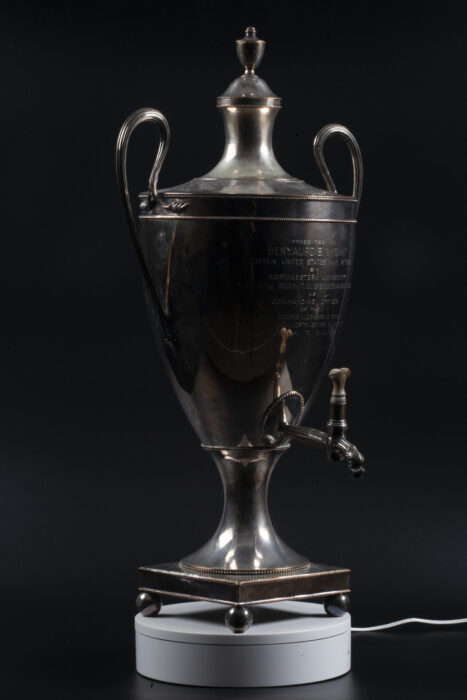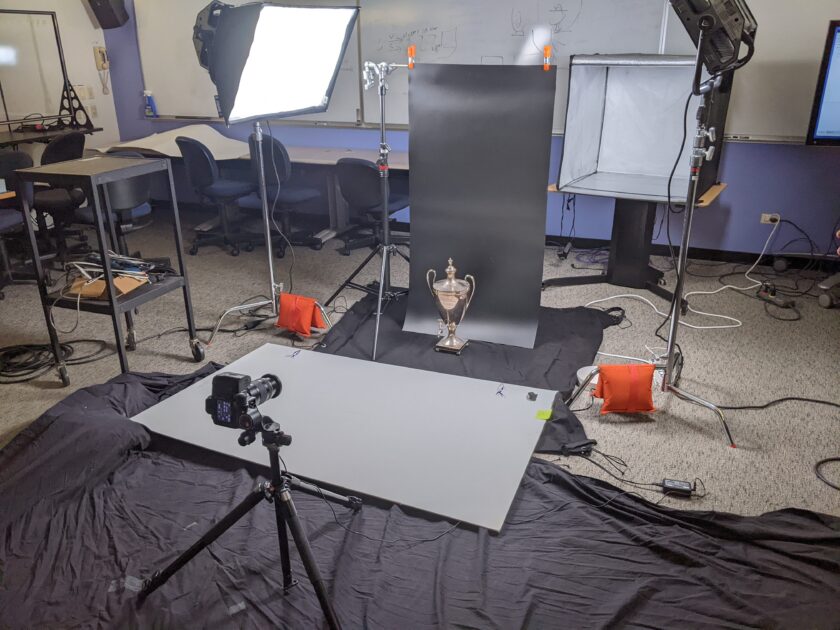Photogrammetry is the process of taking multiple images of an object, and processing the images with a computer, in order to create a textured 3D model of the object. These 3D models can then be used to create new experiences on the Web, in Augmented Reality & Virtual Reality, or printed in 3D as a physical object.
This blog post is technical in nature, and goes in-depth on the efforts put into a recent project.

Image of the trophy from the camera used to do the photogrammetry

Behind the scenes photo of the trophy on vinyl background
Zoran and I tried to do a photogrammetry scan of this Coffee Maker/trophy. It is a highly reflective surface, and has many curves as well, so we knew this would be challenging. Zoran tried photographing it in the 32″x32″ light box, but the trophy was very large, and there were unflattering reflections resulting from the white and silver sides of the light box, but also from the hole in the front, as the trophy reflects the camera as well.
We then tried setting it up on the white vinyl on a table top, holding the vinyl up with a C stand arm. The white was nice for behind the trophy, giving it nice contrast, but because it was a small piece of vinyl, it created an unflattering reflection in the bottom of the cup, similar to the reflection above. For lighting, we used two Litepanels Gemini 2×1, one with a softbox, and one without, to see if there was any significant difference. We couldn’t detect one.
The black vinyl had a similar problem, so we tried putting the trophy directly on the floor, using a 6×6 black flag that we hoped would be less reflective than the vinyl. We hung the vinyl behind the trophy.
This kind of worked, but the text on the trophy was really hard to read, so we put a white card on the floor, and that helped make the text more readable, but the white card was too small, only making some of the text more readable, despite being about a 3’x5′ board.

Wider behind the scenes shot of the trophy, showing lighting, camera and backdrops.
To scan a one-of-a-kind artifact like this, as-is, requires a complicated setup.
- One option would be to construct a larger white lightbox, and light it from the outside through diffused white fabric, and obscuring the lens when it peers through the fabric.
- Something that could help would be a two way mirror in front of the lens to block the reflection of the lens, though this might result in seeing the trophy instead.
- We could also be more creative in our lighting, perhaps lighting it directly from above, and using the tent/lightbox to illuminate it from the sides by reflection off the fabric.
- One thing to consider is that the smaller the diameter of the “tube”, the smaller the reflection, but at some point the reflection is less of an object, and more just a specular highlight. It may be difficult to get an even lighting over the whole object because of this.
- We may be able to build a larger lightbox with our newly acquired 6×6 frames and rags, but we have not tried. We could suspend the light source over the lightbox using the Menace arm kit. This would take up a lot more space in the studio than the current lightbox does, however.
- Another option would be to get the top parts of the trophy looking good, perhaps using a polarizing filter on either the camera, lights, or both. [see the sketchfab article below] Then photograph it from all angles, then light it so the middle looks good, then photograph it from all angles, and then light it so the bottom looks good, then photograph it from all angles. Then the three images for * each* camera and turntable position would need to be combined into one image, and then those composite images sent to the photogrammetry software for processing. This would require very precise camera and lighting positioning.
- If we would be able to alter the artifact, we could spray it with one of these sprays:
- https://www.capture3d.com/3d-metrology-solutions/consumables/aesub-blue-vanishing-3d-scanning-spray
- https://www.conrad.com/p/3d-coating-spray-david-coating-spray-500-1218840
- These sprays change the shiny surface to matte, which means that the images can be captured much more easily, as the reflections are diffused. The sprays either need to be cleaned off, or they evaporate/disappear after a certain amount of time. It is not known now if these sprays would damage the trophy, Zoran is looking into that.
- Then after the photogrammetry was complete, the surface texture would need to be rebuilt in Blender, but the overall shape would be correct.
https://sketchfab.com/blogs/community/capturing-reflective-objects-in-3d/
https://www.3dscanstore.com/blog/3d-scanning-reflective-objects
https://www.dpreview.com/forums/thread/2763903#forum-post-34728304
https://www.autocam360.com/multi-axis [this could be used for precise camera movements]
